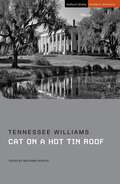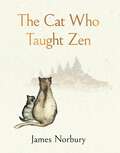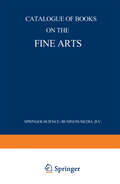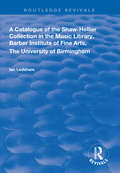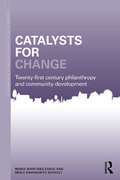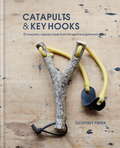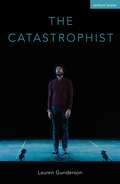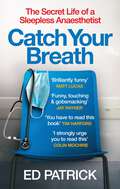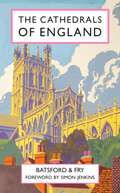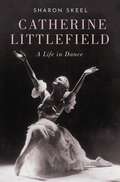- Table View
- List View
Cat Knits: 16 pawsome knitting patterns for yarn and cat lovers
by Marna GilliganThis is the ultimate cat lover's collection of knitting patterns for garments and accessories. If you love cats and yarn you will want this collection of 16 quirky designs all based around the theme of cats. It includes four garments graded for 16 different sizes, as well as cat-themed accessories including a wrap, shawl, scarf, cowl, capelet, mittens and hats. The patterns are divided up into four chapters, each with a different style of cat-themed design similar to Marna's Sinister Catdigan pattern.
Cat on a Hot Tin Roof (Student Editions)
by Tennessee Williams'Williams's favourite among his plays, [Cat on a Hot Tin Roof] is perhaps his most impassioned and articulate statement on human isolation, the wrenching problems of communication between people and the ways in which death defines life.' NEW YORK TIMESIn Cat on a Hot Tin Roof, a Southern family meet to celebrate 'Big Daddy' Pollitt's 65th birthday. But as the party unfolds, the facade of a happy family gathering is fractured by sexual frustration, repressed love and greed in the light of their father's impending death. This edition includes a commentary by Benjamin Hudson, which explores the major themes of the play, including illness and mortality; white supremacy through the plantation setting; mendacity and 'fake news'; alcoholism and addiction; as well as sexuality, womanhood and mid-century notions of masculinity. It draws attention to the context of the play, including the cultural, social and political landscape of the Mississippi Delta and St. Louis; the first-hand witnessing of Black life in the South; homosexuality and outsider sympathy; and American conservatism and the idealised 1950s family. It also delves into recent productions and adaptations of the play, including the Bollywood and Antoine Fuqua film adaptations.
Cat on a Hot Tin Roof (Student Editions)
by Tennessee Williams'Williams's favourite among his plays, [Cat on a Hot Tin Roof] is perhaps his most impassioned and articulate statement on human isolation, the wrenching problems of communication between people and the ways in which death defines life.' NEW YORK TIMESIn Cat on a Hot Tin Roof, a Southern family meet to celebrate 'Big Daddy' Pollitt's 65th birthday. But as the party unfolds, the facade of a happy family gathering is fractured by sexual frustration, repressed love and greed in the light of their father's impending death. This edition includes a commentary by Benjamin Hudson, which explores the major themes of the play, including illness and mortality; white supremacy through the plantation setting; mendacity and 'fake news'; alcoholism and addiction; as well as sexuality, womanhood and mid-century notions of masculinity. It draws attention to the context of the play, including the cultural, social and political landscape of the Mississippi Delta and St. Louis; the first-hand witnessing of Black life in the South; homosexuality and outsider sympathy; and American conservatism and the idealised 1950s family. It also delves into recent productions and adaptations of the play, including the Bollywood and Antoine Fuqua film adaptations.
Cat People (BFI Film Classics)
by Kim NewmanNovelist and critic Kim Newman assesses the horror noir Cat People (1943), produced by Val Lewton and directed by Jacques Tourneur. This important and influential film is considered in the light of its place in film history and as a work of ambitious horror. The new edition includes a postscript about the sequel, The Curse of the Cat People.
Cat People (BFI Film Classics)
by Kim NewmanNovelist and critic Kim Newman assesses the horror noir Cat People (1943), produced by Val Lewton and directed by Jacques Tourneur. This important and influential film is considered in the light of its place in film history and as a work of ambitious horror. The new edition includes a postscript about the sequel, The Curse of the Cat People.
The Cat Who Taught Zen: The beautifully illustrated new tale from the bestselling author of Big Panda and Tiny Dragon
by James NorburyTHE BIG PANDA AND TINY DRAGON AUTHOR AND ILLUSTRATOR JAMES NORBURY TELLS THE STORY OF THE CAT WHO LEARNED HOW TO BE MORE ZEN . . ."I've learnt that what we want is seldom what we need, and what we need is almost never what we want"This is the tale of a cat wise in the ways of zen, journeying to discover a fabled ancient pine, under which infinite wisdom may be found.Along the way he meets a vivid cast of animals: from an anxious monkey and a tortoise tired of life, to a tiger struggling with anger, a confused wolf cub and a covetous crow.But it's a surprise encounter with a playful kitten, that forces the cat to question everything . . .Told in a gentle, calming style, The Cat Who Taught Zen introduces a new cast of characters for readers of all ages to fall in love with, offering timeless wisdom wrapped up into a tale of beguiling beauty.__________Big Panda and Tiny Dragon, Sunday Times bestseller, July 2022
A Catalogue of the Shaw-Hellier Collection (Routledge Revivals)
by Ian LedshamIn this compilation, first published in 1999, Ian Ledsham compiles an extensive catalogue of the Shaw-Hellier Collection, complete with diagrams regarding how we use text.
A Catalogue of the Shaw-Hellier Collection (Routledge Revivals)
by Ian LedshamIn this compilation, first published in 1999, Ian Ledsham compiles an extensive catalogue of the Shaw-Hellier Collection, complete with diagrams regarding how we use text.
Catalysts for Change: 21st Century Philanthropy and Community Development (Community Development Research and Practice Series)
by Maria Martinez-Cosio Mirle Rabinowitz BussellWinner of the Community Development Society's 2014 Current Research Award! 21st Century Philanthropy and Community fills a gap in the literature on philanthropic organizations and how they intertwine with community development. Drawing first on the history of philanthropic funding, Maria Martinez-Cosio and Mirle Bussell look at developments in the last twenty years in detail, focussing on five key case studies from across America. The authors use their own first hand experiences and research to forge a new path for academic research in an area where it has been lacking. With the current economic climate forcing shrewd spending, foundations need all the guidance they can find on how to appropriately channel their funds in the best way. But how can these sorts of community projects be analyzed for effectiveness? Is there a quantitative rather than qualitative element which can be studied to give real feedback to those investing in projects? Arguing against a one-size-fits-all model, the authors illustrate the importance of context and relationships in the success of these projects.
Catalysts for Change: 21st Century Philanthropy and Community Development (Community Development Research and Practice Series)
by Maria Martinez-Cosio Mirle Rabinowitz BussellWinner of the Community Development Society's 2014 Current Research Award! 21st Century Philanthropy and Community fills a gap in the literature on philanthropic organizations and how they intertwine with community development. Drawing first on the history of philanthropic funding, Maria Martinez-Cosio and Mirle Bussell look at developments in the last twenty years in detail, focussing on five key case studies from across America. The authors use their own first hand experiences and research to forge a new path for academic research in an area where it has been lacking. With the current economic climate forcing shrewd spending, foundations need all the guidance they can find on how to appropriately channel their funds in the best way. But how can these sorts of community projects be analyzed for effectiveness? Is there a quantitative rather than qualitative element which can be studied to give real feedback to those investing in projects? Arguing against a one-size-fits-all model, the authors illustrate the importance of context and relationships in the success of these projects.
Catapults & Key Hooks: Everyday objects made from foraged and gathered wood
by Geoffrey FisherWhether building a bee hotel to help your garden's ecosystem thrive, crafting a catapult, whistle, skipping rope or cup and ball game to give away, or making a key hook or cobweb brush to organise your home, the result of each will be entirely unique while also effortlessly stylish.All basic woodworking techniques are covered, plus Geoffrey also shows how best to prepare materials, including checking for disease, drying and stripping bark, and gives a detailed guide on your essential tool kit - what to have, how to handle your tools safely and how to maintain everything to the highest standard -meaning anyone can pick up Catapults & Key Hooks and dive straight into the world of Geoffrey's designs.
Catastrophe in the Making: The Engineering of Katrina and the Disasters of Tomorrow
by William R. Freudenburg Robert Gramling Shirley Laska Kai T. EriksonBased on the false promise of widespread prosperity, communities across the U.S. have embraced all brands of “economic development” at all costs. In Louisiana, that meant development interests turning wetlands into shipping lanes. By replacing a natural buffer against storm surges with a 75-mile long, obsolete canal that cost hundreds of millions of dollars, they guided the hurricane into the heart of New Orleans and adjacent communities. The authors reveal why, despite their geographic differences, California and Missouri are building—quite literally—toward similar destruction.Too often, the U.S. “growth machine” generates wealth for a few and misery for many. Drawing lessons from the most expensive “natural” disaster in American history, Catastrophe in the Making shows why thoughtless development comes at a price we can ill afford.
The Catastrophist (Modern Plays)
by Lauren GundersonHow do you plan for a catastrophe? Virologist Nathan Wolfe, named one of TIME's 100 Most Influential People in the World for his work tracking viral pandemic outbreaks, proposed pandemic insurance years before the novel coronavirus outbreak. No one bought it. Now, in a post-COVID world, we hear his story. A time-jumping tale based on the life and work of Nathan Wolfe (who also happens to be the playwright's husband). Though not a play about COVID19, it is a true story of a pandemic expert. An deep dive into the profundities of scientific exploration, the lengths one goes for love and family, the bracing truths of fatherhood and discovery, and the harrowing realities of facing your own mortality, The Catastrophist is a world premiere theatrical experience built of and for this moment in time.
The Catastrophist (Modern Plays)
by Lauren GundersonHow do you plan for a catastrophe? Virologist Nathan Wolfe, named one of TIME's 100 Most Influential People in the World for his work tracking viral pandemic outbreaks, proposed pandemic insurance years before the novel coronavirus outbreak. No one bought it. Now, in a post-COVID world, we hear his story. A time-jumping tale based on the life and work of Nathan Wolfe (who also happens to be the playwright's husband). Though not a play about COVID19, it is a true story of a pandemic expert. An deep dive into the profundities of scientific exploration, the lengths one goes for love and family, the bracing truths of fatherhood and discovery, and the harrowing realities of facing your own mortality, The Catastrophist is a world premiere theatrical experience built of and for this moment in time.
Catch Your Breath: The Secret Life of a Sleepless Anaesthetist
by Ed Patrick'Ed's journey is funny, sad, harrowing, hilarious... I STRONGLY URGE YOU TO READ THIS.' - Colin Mochrie A gut punch of a memoir by a doctor - and comedian - whose job is to keep people alive by putting them to sleep.Ed Patrick is an anaesthetist.Strong drugs for his patients, strong coffee for him. But it's not just sleep-giving for this anaesthetist, as he navigates emergencies, patients not breathing for themselves and living with a terrifying sense of responsibility. It's enough to leave anyone feeling numb.But don't worry, there's plenty of laughing gas to be had.'Very funny, very timely, scary in places. Ed writes with wit, insight, surprise and pathos. He is cutting his teeth in anaesthetics, taking people as close to death as you can take them, and then trying to wake them up again. And makes it funny. A joy to read.' - Phil Hammond
Catching Bullets
by Mark O’ConnellWhen Jimmy O'Connell took a job as chauffeur for 007 producers Eon Productions, it would not just be Cubby Broccoli, Roger Moore and Sean Connery he would drive to James Bond his grandson Mark swiftly hitched a metaphorical ride too. In Catching Bullets: Memoirs of a Bond Fan, Mark O'Connell takes us on a humorous journey of filmic discovery where Bond films fire like bullets at a Thatcher era childhood, closeted adolescence and adult life as a comedy writer still inspired by that Broccoli movie magic. Catching Bullets is a unique and sharply-observed love-letter to James Bond, Duran Duran title songs and bolting down your tea quick enough to watch Roger Moore falling out of a plane without a parachute.
Caterina Sforza and the Art of Appearances: Gender, Art and Culture in Early Modern Italy (Women and Gender in the Early Modern World)
by Joyce de VriesIn the first major book in four decades on Caterina Sforza (1463-1509), Joyce de Vries investigates the famous noblewoman's cultural endeavors, and explores the ways in which gender, culture, and consumption practices were central to the invention of the self in early modern Italy. Sforza commissioned elaborate artistic and architectural works, participated in splendid civic and religious rituals, and collected a dazzling array of clothing, jewelry, and household goods. By engaging in these realms of cultural production, de Vries suggests, Sforza manipulated masculine and feminine norms of behavior and effectively promoted her social and political agendas. Drawing on visual evidence, inventories, letters, and contemporary texts, de Vries offers a penetrating new interpretation of women's contributions to early modern culture. She explains the correlations between prescriptive literature and women's actions and reveals the mutability of gender roles in the princely courts. De Vries's analysis of Sforza's posthumous legend suggests that what we see as "the Renaissance" was as much a historical invention as a coherent moment in historical time.
Caterina Sforza and the Art of Appearances: Gender, Art and Culture in Early Modern Italy (Women and Gender in the Early Modern World)
by Joyce de VriesIn the first major book in four decades on Caterina Sforza (1463-1509), Joyce de Vries investigates the famous noblewoman's cultural endeavors, and explores the ways in which gender, culture, and consumption practices were central to the invention of the self in early modern Italy. Sforza commissioned elaborate artistic and architectural works, participated in splendid civic and religious rituals, and collected a dazzling array of clothing, jewelry, and household goods. By engaging in these realms of cultural production, de Vries suggests, Sforza manipulated masculine and feminine norms of behavior and effectively promoted her social and political agendas. Drawing on visual evidence, inventories, letters, and contemporary texts, de Vries offers a penetrating new interpretation of women's contributions to early modern culture. She explains the correlations between prescriptive literature and women's actions and reveals the mutability of gender roles in the princely courts. De Vries's analysis of Sforza's posthumous legend suggests that what we see as "the Renaissance" was as much a historical invention as a coherent moment in historical time.
Cathedrals of Britain (Shire Library)
by David PepinCathedrals are awe-inspiring buildings. Most are grand medieval structures, while others appear simple and unpretentious – yet all were designed to reflect the glory of God and have a profound impact on us. As trailblazers of architectural development, each cathedral has distinct individual features – such as the powerful Norman Romanesque west towers of Durham, the unique octagonal tower at Ely, and the daring late Gothic finery and spaciousness at Gloucester. In this lavishly illustrated guide to cathedrals from Bangor to York, with profiles of Roman Catholic and Scottish cathedrals, David Pepin outlines the evolution of architectural style, each building's key features, and the ongoing story of daily worship, wide-ranging ministry, conservation, the new work of craftspeople, and the increasing numbers of pilgrims and visitors.
Cathedrals of Britain (Shire Library #831)
by David PepinCathedrals are awe-inspiring buildings. Most are grand medieval structures, while others appear simple and unpretentious – yet all were designed to reflect the glory of God and have a profound impact on us. As trailblazers of architectural development, each cathedral has distinct individual features – such as the powerful Norman Romanesque west towers of Durham, the unique octagonal tower at Ely, and the daring late Gothic finery and spaciousness at Gloucester. In this lavishly illustrated guide to cathedrals from Bangor to York, with profiles of Roman Catholic and Scottish cathedrals, David Pepin outlines the evolution of architectural style, each building's key features, and the ongoing story of daily worship, wide-ranging ministry, conservation, the new work of craftspeople, and the increasing numbers of pilgrims and visitors.
Cathedrals of Urban Modernity: Creation of the First Museums of Contemporary Art (Routledge Revivals)
by J. Pedro LorenteFirst published in 1998, this volume explores the expanding wave of a new kind of museums of contemporary art in the nineteenth and early twentieth centuries. Lorente examines their ‘coming of age’ and the weight of their museological legacy, arguing that the establishment of great national museums of art at London and Paris radiated out, carrying their influence with it. This book emerged as part of a series on towns and cities and has a focus on London and Paris as centres of artistic innovation.
Cathedrals of Urban Modernity: Creation of the First Museums of Contemporary Art (Routledge Revivals)
by J. Pedro LorenteFirst published in 1998, this volume explores the expanding wave of a new kind of museums of contemporary art in the nineteenth and early twentieth centuries. Lorente examines their ‘coming of age’ and the weight of their museological legacy, arguing that the establishment of great national museums of art at London and Paris radiated out, carrying their influence with it. This book emerged as part of a series on towns and cities and has a focus on London and Paris as centres of artistic innovation.
Catherine Littlefield: A Life in Dance
by Sharon SkeelWhile she is best remembered today as founder of the Philadelphia Ballet and the director and driving force behind the famous Littlefield School of Ballet, from which Balanchine drew the nucleus for his School of American Ballet, Catherine Littlefield (1905-51) and her oeuvre were in many ways emblematic of the full representation of dance throughout entertainments of the first half of the 20th century. From her early work as a teenager dancing for Florenz Ziegfeld to her later work in choreographing extravagant ice skating shows, a remarkable dance with 90 bicyclists for the 1940 World's Fair, and on television as resident choreographer for The Jimmy Durante Show, Littlefield was amongst the first choreographers to bring concert dance to broader venues, and her legacy lives on today in her enduring influence on generations of American ballet dancers. As the first biography of Littlefield, Catherine Littlefield: A Life in Dance traces her life in full from birth through childhood experiences dancing on the Academy of Music's grand stage, and from her foundation of the groundbreaking Philadelphia Ballet Company in 1935 to her later work in television and beyond. Littlefield counted among her many glamorous friends and colleagues writer Zelda Fitzgerald, conductor Leopold Stokowski, and composer Kurt Weill. This biography also provides an engrossing portrait of the remarkable Littlefield family, many of whom were instrumental to Catherine's success. With the unflagging support of her generous husband and indomitable mother, Littlefield gave shape to the course of American ballet in the 20th century long before Balanchine arrived in the United States.

